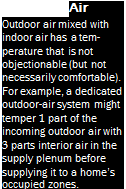Balanced Ventilation Brings in the Good Air, Banishes the Bad, and Conserves Energy
The best way to temper incoming air while reducing HVAC energy consumption is to use a heat-recovery ventilator (HRV) or an energy-recovery ventilator (ERV). These systems (see the drawing on the facing page) are balanced approaches that use the temperature and humidity of an exhaust-air stream (which otherwise would have been wasted) to temper the air of a supply stream, thereby reducing the HVAC energy cost. An HRV heats or cools incoming fresh air and can recapture up to 80% of the energy that would be lost without it. ERVs are better suited for hot, humid climates because they dry incoming air, thus reducing the work that the air conditioner has to do.
You Still Need to Clean Up
Ventilation is good at diluting gaseous compounds and small particles because small particles act like gases. They mix quickly in the air and follow air currents when air is
 expelled. But large particles such as pollen, pet dander, and dust mites must be cleaned up or vacuumed rather than exhausted or diluted because they’re too heavy to mix with air. Other large particles, called semi-VOCs, are solids or liquids at room tempera – ■* ture. While they’re not gaseous, as with VOCs, they are volatile enough to emit lots of gaseous vapor. This is important, because if you filter out SVOC particulates you haven’t really done anything until you clean the filter; the SVOCs keep emitting gaseous vapor from the filter. If you don’t replace filters on your HVAC system regularly, the system itself becomes a contamination source.
expelled. But large particles such as pollen, pet dander, and dust mites must be cleaned up or vacuumed rather than exhausted or diluted because they’re too heavy to mix with air. Other large particles, called semi-VOCs, are solids or liquids at room tempera – ■* ture. While they’re not gaseous, as with VOCs, they are volatile enough to emit lots of gaseous vapor. This is important, because if you filter out SVOC particulates you haven’t really done anything until you clean the filter; the SVOCs keep emitting gaseous vapor from the filter. If you don’t replace filters on your HVAC system regularly, the system itself becomes a contamination source.
The three ventilation systems discussed here are by no means comprehensive; they can be combined in various recipes to meet particular conditions. In addition to climate and house tightness, cost can be a big consideration, but it shouldn’t be the major one. Be sure to consider long-term durability and maintenance requirements. Systems with heat recovery (HRV/ERV) require a lot more maintenance than those without. Systems with multiple filters or requiring seasonal adjustment can be confusing.
Tight Houses Are Good, and They Should Breathe
Excessive leaks are one way for a house to breathe, but not the best. While there’s a lot of ongoing research and a robust scholarly debate on the best way to achieve acceptable indoor-air quality, building scientists all agree that houses need to breathe.
As houses become higher and higher performance, they need to breathe in a steady, reasonably controllable way. We cannot afford to let them breathe at the whim of the weather or with windows only. We also sometimes need to be able to have them hold their breath when conditions outside are exceptionally bad. Only with designed ventilation systems can we make sure that indoor-air quality and energy efficiency advance hand in hand.
Dr. Max H. Sherman is a consulting building scientist and physicist at Lawrence Berkeley National Laboratory in Berkeley, Calif.






Leave a reply